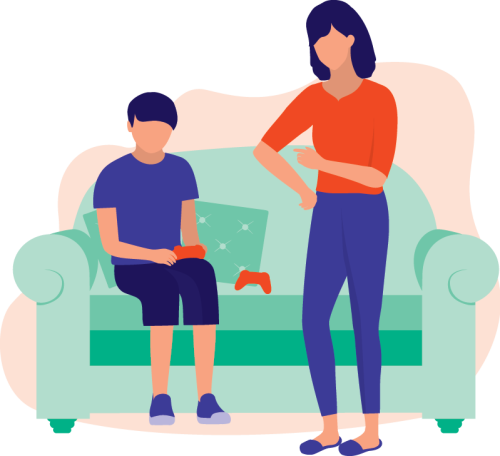Dealing with Big Emotions
Big emotions, such as sadness and anger, can be challenging because these feelings often are not predictable. There are strategies that can help your child learn to calm themselves.
Goal

Overview
When upset, frustrated, or angry, children may not be open to learning new calming strategies. It is very difficult for them to learn a new skill when upset, tired, or feeling unwell.
Adults experience this, too. Imagine driving to an unfamiliar place for a job interview during a thunderstorm. You are already pretty anxious about the interview, and the thunderstorm has you on high alert. This might make it really hard for you to learn the route to this new place. Imagine instead that you had gone that route many times before in low-stress situations (no interview and good weather). You would probably learn the route pretty quickly AND be able to apply it if you found yourself in a stressful situation.
The same goes for your child. The best time is to practice handling big emotions is when your child is already calm, so the skills become familiar and easy. Once your child has mastered the skill, it will be easier to use when they are frustrated. Then when your child is having big emotions, they don’t have to think so much about using the strategies—it will become almost automatic.
Method
There are six components to help with big emotions.

Practice self-calming strategies.
Have your child practice self-calming exercises every day. The more your child practices, the quicker they will master the skill. Self-calming strategies often involve deep breathing, distraction, and/or mindfulness.
Self-Calming Activities
Practice exercises when your child is calm because that is when it is easier to learn new things. Make sure to name the strategy accordingly (for example, “Let’s practice blowing bubbles!”). When your child is upset, you’ll want to be able to quickly refer to the strategy.
It may take some trial and error to find a strategy that feels comfortable for your child, so you might need to try out a few different ones.

Model and share.
Try to identify times when you deal effectively with your own stressors and point these out to your child. Share your coping strategy with your child to give them an example of how they could deal with a similar situation. You can also invite them to join you in using the strategy.
For example, imagine you nearly got into a car accident because someone ran a red light. You could pull over and say,
“Right now mommy is feeling really angry because that driver almost hit my car. I’m going to practice deep breathing. Do you want to practice with me?”
Your child doesn’t have to practice with you, so don’t force them. But continue to model the strategy while your child watches.

Prompt the strategy when needed.
When your child starts to get upset, briefly encourage them to practice their self-calming exercises (use whatever name you gave the exercises in practice), and then stay out of the situation completely.
Prompt as soon as you can.
The sooner you prompt, the easier it will be for them to try it. If you wait until they lose control, the exercises probably will not help. It is much easier to calm down if you are just starting to get upset versus when you are highly upset.

Use rewards.
Sit down with your child and identify some rewards that they can earn by practicing and using their calming exercises. Rewards should be given for practicing while calm (Step 1) and for using the strategy when upset (Step 3).
Don’t skip the rewards.
Managing big emotions is really hard, and rewards will let your child know they are on the right track. When you give the reward, tell them exactly what it is for.
“I am so proud of you for using your 5-4-3-2-1 strategy. You earned 10 extra minutes of iPad time!”

Use your discipline strategies when anger turns into action.
It is important to teach your child that anger is a normal feeling. There are times when your child’s anger may be justified, so you must teach your child how to appropriately and constructively express it.
For example, your child may be angry that their sister broke their favorite toy, and they may hit her. The anger is justified, but the way they expressed their anger is not.
If you have an established discipline strategy like putting your child in time-out when they hit, continue to use this strategy. Don’t get drawn into negotiations or debates.

Practice problem solving.
Teach your child what they should do when they feel angry. They may want to yell or act out, but there is always a better way to respond.
Teach your child how to problem-solve, which involves them answering the following questions:
What exactly is the problem?
Have your child describe the problem. For example, “The dog keeps chewing my action figures.”
What can I do?
Create a list of things they can do in this situation. For example, your child could make sure to put the toys away or close their door.
What should I do right now?
Using the list, your child should pick an option. Your child might choose to shut the door while they are playing so the dog cannot get the toys.
How can I plan ahead next time?
Your child should use the list to prevent this problem in the future. This might mean storing the action figures in a box with a lid while not using them.
How did I do?
Your child should be able to tell you whether the solution they picked worked. Did the dog stop ruining their toys? Would another option have worked better?
You can use real or made-up situations when you practice. Give your child a situation that did or could make them angry and ask each of the above questions. Problem-solving will be easier to teach older children (around 8 years or older), but that doesn’t mean you cannot try with a child as young as 4-5 years. Be prepared to walk them through each of the problem-solving steps, including helping them brainstorm options and make good choices.
Challenges
My child refuses to use a calming strategy when they are upset.
This is completely normal. Focus on practicing when they are calm. The more they practice, the more automatic it will become.
My child does not want to practice.
Don’t skip the rewards. If you are using a reward and it does not seem to be working, try another reward or give your child a choice of rewards.
The strategies don't work when my child is really upset.
Anticipate big emotions. It is much easier to use the strategies before the big meltdown than while it is in progress. Pay attention to what usually triggers their big emotions, and remind your child to use their strategies before they start to spiral out of control. For example, “I see that you cannot get those blocks to fit together the way you want. Let’s stop for a moment and practice your breathing exercises.”
I don't know what to do when my child starts to have a meltdown.
Don’t give in. If the emotions were triggered by being denied something or being told to do something, follow through and do not give in. Refer to Managing Tantrums and How to Teach Accepting “No” for more helpful tips.
Practice
Practice while your child is calm for the next few weeks.

Prepare
Pick out some self-calming strategies to teach your child.

Apply
Find a time when your child is calm to practice a strategy.

Repeat
Practice at least one self-calming strategy and one problem-solving strategy per day.
Next Steps
Prompt the strategies in real situations.
As your child gets good at practicing self-calming and problem-solving strategies when calm, remind them to use the strategies when they are upset or angry. Do this before they are in a situation that might trigger big emotions or as soon as you notice the first signs of distress.
For example, if your child often becomes upset when a sibling plays with their toys, you can remind them to use their coping strategies when you notice their younger sister entering the room.
